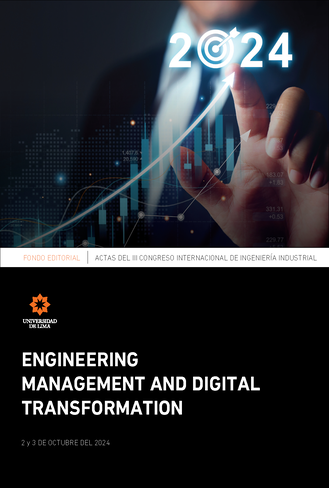United we transform: harnessing ai for Peruvian SMEs digital success
Abstract
Digital transformation is crucial for the competitiveness and innovation of businesses in today’s rapidly evolving technological landscape. This study examines the critical role of Artificial Intelligence (AI) in facilitating digital transformation among small and medium-sized enterprises (SMEs) in Peru. Considering the gap in the current literature on the digital transformation processes of Peruvian SMEs, this study develops a survey grounded in traditional concepts such as dynamic capabilities and innovative methodologies derived from AI project management experts globally. The responses from 80 Peruvian SMEs are analyzed using a dProbit econometric model to identify the barriers and opportunities they face in adopting AI-driven technologies. The results emphasize the importance of dynamic capabilities, particularly the transforming capability, which involves the continuous renewal and strategic reconfiguration of a SME’s resources. This research enhances understanding of the importance of nurturing a culture of collective thinking and leveraging organizational memory not only within individual SMEs but also among them. Since digital transformation is a continuous and evolving process, it requires the retention and application of collective memory to navigate its complexities and sustain progress over time. This research has also significant implications for SMEs seeking to foster value networks among themselves.
Downloads
References
Akter, S., Michael, K., Uddin, M. R., McCarthy, G., & Rahman, M. (2020). Transforming business using digital innovations: the application of AI, blockchain, cloud, and data analytics. Annals of Operations Research, 308, 7-39. https://doi.org/10.1007/s10479-020-03620-w
Castelo-Branco, I., Cruz-Jesus, F., & Oliveira, T. (2019). Assessing Industry 4.0 readiness in manufacturing: Evidence for the European Union. Computers in Industry, 107, 22-32. https://doi.org/10.1016/j.compind.2019.01.007
Centro Nacional de Planeamiento Estratégico. (2023). Transformación digital: Panorama actual y principales perspectivas. https://cdn.www.gob.pe/uploads/document/file/5623538/4984523-ceplan-transformacion-digital-panorama-actual-y-principales-perspectivas.pdf
Christensen, C. M., Anthony, S. D., & Roth, E. A. (2004). Seeing what’s next: Using the theories of innovation to predict industry change. Harvard Business School Press.
Dini, M., & Stumpo, G. (Coords.). (2020). Mipymes en América Latina: un frágil desempeño y nuevos desafíos para las políticas de fomento. Comisión Económica para América Latina y el Caribe. https://repositorio.cepal.org/entities/publication/cbe085f5-48c5-4458-a158-b5c07f3c9c91
Fitzgerald, M., Kruschwitz, N., Bonnet, D., & Welch, M. (2014). Embracing digital technology: A new strategic imperative. MIT Sloan Management Review, 55(2), 1-12. https://www.proquest.com/scholarly-journals/embracing-digital-technology-new-strategic/docview/1475566392/se-2
Kim, S., Choi, B., & Lew, Y. K. (2021). Where is the age of digitalization heading? The meaning, characteristics, and implications of contemporary digital transformation. Sustainability, 13(16), 8909. https://doi.org/10.3390/su13168909
Malik, H., & Malik, A. S. (2011). Towards identifying the challenges associated with emerging large scale social networks. Procedia Computer Science, 5, 458-465. https://doi.org/10.1016/j.procs.2011.07.059
Mittal, S., Khan, M. A., Romero, D., & Wuest, T. (2018). A critical review of smart manufacturing Industry 4.0 maturity models: Implications for small and medium-sized enterprises (SMEs). Journal of Manufacturing Systems, 49, 194-214. https://doi.org/10.1016/j.jmsy.2018.10.005
Morandín-Ahuerma, F. (2022). What is artificial intelligence? International Journal of Research Publication and Reviews, 3(12), 1947-1951. https://doi.org/10.55248/gengpi.2022.31261
North, K., Aramburu, N., Lorenzo, O., & Zubillaga Rego, A. (2019, 5-7 de junio). Digital maturity and growth of SMEs: A survey of firms in the Basque country (Spain) [Presentación de escrito]. Finland of International Forum on Knowledge Assets Dynamics, Matera, Italia.
Oehmen, J., & Hielscher, U. (2023). The five questions to answer in your digitalization strategy. In The Digital Transformation Playbook (2.a ed., pp. 113-122). Project Management Institute.
Okfalisa, O., Anggraini, W., Nawanir, G., Saktioto, S. & Wong, K. Y. (2021). Measuring the effects of different factors influencing on the readiness of SMEs towards digitalization: A multiple perspectives design of decision support system. Decision Science Letters, 10(3), 425-442. http://dx.doi.org/10.5267/j.dsl.2021.1.002
Sultan, N. (2013). Cloud computing: A democratizing force? International Journal of Information Management, 33(5), 810-815. https://doi.org/10.1016/j.ijinfomgt.2013.05.010
Teece, D. J. (2014). A dynamic capabilities-based entrepreneurial theory of the multinational enterprise. Journal of International Business Studies, 45, 8-37. https://doi.org/10.1057/jibs.2013.54
Viana Vargas, R., & Nieto-Rodriguez, R. (2023). Are you willing and ready to embrace AI? In The Digital Transformation Playbook - What You Need to Know and Do. Thinkers50, Project Management Institute.
Williams, C., Schallmo, D., Lang, K., & Boardman, L. (2019, 16-19 de junio). Digital maturity models for small and medium-sized enterprises: A systematic literature review [Presentación de escrito]. The ISPIM Innovation Conference, Celebrating Innovation: 500 Years Since da Vinci, Florencia, Italia.
World Economic Forum. (2016, 21 de enero). 100 trillion by 2025: The digital dividend for society and business. https://www.weforum.org/press/2016/01/100-trillion-by-2025-the-digital-dividend-for-society-and-business/

This work is licensed under a Creative Commons Attribution 4.0 International License.


